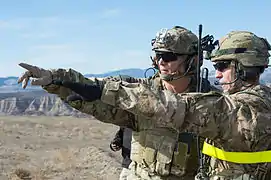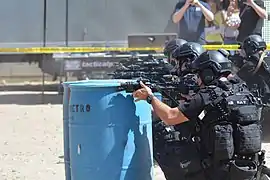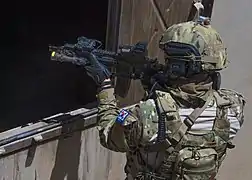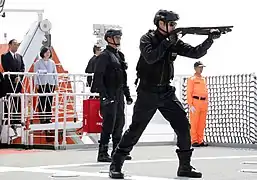Future Assault Shell Technology helmet
The Ops-Core Future Assault Shell Technology (FAST) Helmet, also known as the FAST helmet, is a combat helmet used by special operations forces and law enforcement organizations.
| Future Assault Shell Technology helmet | |
|---|---|
 U.S. Marine Raider wearing a FAST Maritime helmet. | |
| Type | Combat helmet |
| Place of origin | United States of America |
| Service history | |
| In service | 2009 – present |
| Used by | See Users |
| Wars | War on Terror |
| Production history | |
| Designer | U.S. Army Research Laboratory in collaboration with the U.S. Army Natick Soldier Research, Development and Engineering Center and the Program Executive Office (PEO) Soldier |
| Manufacturer | Ops-Core (apart of Gentex) |
| Produced | 2007 – present |
| Variants | ballistic:
non-ballistic:
|
| Specifications | |
| Weight | 315–1034 g (0.69–2.28 lbs), depending on size and model |
The FAST helmet series is characteristic for its shell shape – ear cut geometry which extends critical coverage over the rear occipital bone without load carrier interference, and optimizes weight distribution for increased stability, integration, balance, and improved comfort. Along with the cut, the helmet is distinctive by one of its primary design features including the various suspension and retention systems, and the ARC rails which enable mounting of helmet lights and cameras.
History
It was developed by the U.S. Army Research Laboratory in collaboration with the U.S. Army Natick Soldier Research, Development and Engineering Center and the Program Executive Office (PEO) Soldier as part of the Army Manufacturing Technology (ManTech) Program, which led to the development of other helmets such as the Maritime helmet and the Enhanced Combat Helmet (ECH).[1][2]
The name FAST helmet was coined by a manufacturing company called Ops-Core in 2005.[3] In 2008, Ops-Core showed off their prototype helmet with their Head-Loc™ Helmet Retention System (a.k.a. Head-Loc Retention System) at the 2008 SHOT SHOW convention. The helmet was publicly revealed in 2009 at the annual SHOT Show.[4] It was issued to U.S. special forces operators deployed in Afghanistan.[5]
Development
Compared to standard combat helmets, the FAST helmet offers up to 25% weight reduction and is notable for its early use of ultra-high-molecular-weight polyethylene fibers (UHMWPE) in its design.[1][2] It was also designed to allow outside features such as wearing communications headsets which can be attached with rail adapters.[6]
Design
The FAST helmet ranges in weight from about 315 to 1034 g (0.69 to 2.28 lbs). The type of UHMWPE material for the ballistic FAST models provides increased protection against handgun rounds. It can be fitted with a mounting bracket for different optical devices like night vision goggles on the front, similar to MICH and PASGT. Users can wear it with different communications headsets with ease and comfort. It has different color options, such as tan 499, foliage green, Ranger green, black, urban gray, urban tan, MultiCam and MultiCam Black, AOR1 and AOR2. As well as having mesh and cloth helmet covers in varying camouflage patterns.
Users
 Austria: 20,000 Sentry XP Mid Cut-type helmets ordered in 2016, adopted by the Austrian Armed Forces in 2017.[7]
Austria: 20,000 Sentry XP Mid Cut-type helmets ordered in 2016, adopted by the Austrian Armed Forces in 2017.[7] France: Used by French special operations forces.[8] Reported by a 1st Marine Infantry Paratroopers Regiment commando, who credited the helmet with saving him from being shot in the head during the 2015 Bamako hotel attack.[8]
France: Used by French special operations forces.[8] Reported by a 1st Marine Infantry Paratroopers Regiment commando, who credited the helmet with saving him from being shot in the head during the 2015 Bamako hotel attack.[8] Malaysia: In 2016, a contract was signed with Usahawan PSE Sdn Bhd to supply FAST helmets to the Malaysian military under RM45.9 million.[9] The first Malaysian unit issued with the helmet is the 7th Royal Ranger Regiment.[10]
Malaysia: In 2016, a contract was signed with Usahawan PSE Sdn Bhd to supply FAST helmets to the Malaysian military under RM45.9 million.[9] The first Malaysian unit issued with the helmet is the 7th Royal Ranger Regiment.[10] Norway: In 2011, the Norwegian Defense Logistic Organization (NDLO) selected the FAST helmet as the new standard issue protective headgear for the Norwegian Army and National Guard. The decision was made after positive results from rounds of ballistic and safety testing and has been previously fielded by the Norwegian Special Forces in both Afghanistan and Iraq.[11] This replaces the PASGT made by Cato Ringstad.[12]
Norway: In 2011, the Norwegian Defense Logistic Organization (NDLO) selected the FAST helmet as the new standard issue protective headgear for the Norwegian Army and National Guard. The decision was made after positive results from rounds of ballistic and safety testing and has been previously fielded by the Norwegian Special Forces in both Afghanistan and Iraq.[11] This replaces the PASGT made by Cato Ringstad.[12] Poland: Used by JW GROM and JW Formoza operators.[13]
Poland: Used by JW GROM and JW Formoza operators.[13]- .
 Sweden: Used by Särskilda operationsgruppen (FAST Maritime helmets)[13]
Sweden: Used by Särskilda operationsgruppen (FAST Maritime helmets)[13]  Turkey: Used by the Turkish Army, with a reported incident where a Turkish soldier's life was saved when his Ops-Core Sentry-type helmet was shot at in 2015.[14]
Turkey: Used by the Turkish Army, with a reported incident where a Turkish soldier's life was saved when his Ops-Core Sentry-type helmet was shot at in 2015.[14] Ukraine: Used by Ukrainian spetsnaz forces.[15]
Ukraine: Used by Ukrainian spetsnaz forces.[15] United Arab Emirates: The UAE Presidential Guard is equipped with the FAST Ballistic High Cut helmet, announced in 2013.[16]
United Arab Emirates: The UAE Presidential Guard is equipped with the FAST Ballistic High Cut helmet, announced in 2013.[16] United States: Used by special operations forces. Delta Force has used the FAST XP helmet (MultiCam shell) officially since 2015, though SF (also in MultiCam) is in use as well. Some DEVGRU operators had used the FAST XP (with AOR1 paintjob) until the FAST Maritime (AOR1 shell) started being officially issued in 2011. Navy SEALs use the LBH (an XP, but with a different velcro shape pattern) with AOR1 shell and SWCC with AOR2 shell. AFSOC, Special Forces (Green Berets), 75th Ranger Regiment and Marine Raider Regiment use the FAST Maritime.[1][17]
United States: Used by special operations forces. Delta Force has used the FAST XP helmet (MultiCam shell) officially since 2015, though SF (also in MultiCam) is in use as well. Some DEVGRU operators had used the FAST XP (with AOR1 paintjob) until the FAST Maritime (AOR1 shell) started being officially issued in 2011. Navy SEALs use the LBH (an XP, but with a different velcro shape pattern) with AOR1 shell and SWCC with AOR2 shell. AFSOC, Special Forces (Green Berets), 75th Ranger Regiment and Marine Raider Regiment use the FAST Maritime.[1][17]
Gallery
References
- "ARL-led program enables new manufacturing processes for ballistic protection". EurekaAlert!. May 16, 2012. Retrieved August 27, 2018.
- National Research Council (2014). Review of Department of Defense Test Protocols for Combat Helmets. Washington, D.C.: National Academies Press.
- "THE FAST HELMET | FUTURE ASSAULT SHELL TECHNOLOGY EXPLAINED". Hard Head Veterans. June 1, 2018. Retrieved August 27, 2018.
- "Ops-Core Releases New Products - Soldier Systems Daily".
- Crane+, David. "Ops-Core FAST Ballistic Helmet (Crye MultiCam Camo Pattern?) Military Combat Helmet with FAST-ARC Accessory Rail Connectors and Head-Loc Chinstrap Retention System Going Operational in Afghanistan with U.S. Army Special Forces: FAST Helmet Demo Video, and Contour HD Tactical Helmet Cam (Camera) Photos!". DefenseReview.com (DR): An online tactical technology and military defense technology magazine with particular focus on the latest and greatest tactical firearms news (tactical gun news), tactical gear news and tactical shooting news.
- Scharine, Angelique; Weatherless, Rachel (September 2013). "Evaluation of Variants of 3M Peltor ComTAC Tactical Communication and Protection System (TCAPS) Headsets: Measures of Hearing Protection and Auditory Performance". U.S. Army Research Laboratory – via ResearchGate.
- http://sipol.at/en/2017/03/30/new-gear/
- http://www.veterans-jobs-center.com/vjc/les-chroniques-de-vjc/forces-speciales-retex-ou-quand-le-bon-matos-t-evite-d-etre-porte-par-six-.html
- "Contracts Worth US$ 745 Million Announced At DSA 2016". www.defenseworld.net.
- "New Ballistic Helmets for the Army - Malaysian Defence".
- "Ops-Core Helmets for the whole Norwegian Army". Military Times. September 7, 2011. Retrieved August 27, 2018.
- http://soldiersystems.net/2011/09/08/ops-core-wins-norwegian-helmet-contract/
- https://web.archive.org/web/20190927152509/http://www.special-ops.pl/artykul/id319,shot-show-2013?p=5
- "Ops-Core Helmet Saves Turkish Soldier's Life - Soldier Systems Daily".
- https://www.thedrive.com/the-war-zone/11305/ukrainian-spetnazs-weapons-and-gear-may-show-an-american-touch
- "Ops-Core Awarded Contract to Supply UAE with the Ops-Core FAST Ballistic High Cut (XP) Helmet". Gentex. 12 November 2013.
- "Combat Helmets Have Moved Beyond Just Protection". Task & Purpose. 12 June 2015.
- "Ops-Core Helmet Saves LAPD SWAT Officer's Life - Soldier Systems Daily".
- https://web.archive.org/web/20190416191647/https://www.fbo.gov/index.php?s=opportunity&mode=form&id=530709eb3f91576ec54d9e928ca6226e&tab=core&_cview=1
External links
| Wikimedia Commons has media related to Ops-Core Helmet. |
_checkpoint_in_Helmand_province%252C_Afghanistan%252C_March_30%252C_2013_130330-M-BO337-085.jpg.webp)
.jpg.webp)







